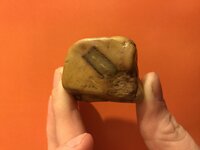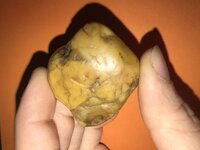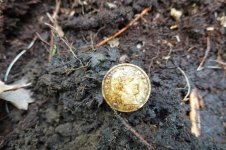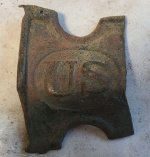You are using an out of date browser. It may not display this or other websites correctly.
You should upgrade or use an alternative browser.
You should upgrade or use an alternative browser.
Fossil?
- Thread starter Jessmc
- Start date
-
- Tags
- fossil ? rock?
old digger
Gold Member
- Jan 15, 2012
- 7,505
- 7,304
- Detector(s) used
- White's MXT
- Primary Interest:
- All Treasure Hunting
It does not look like a fossil.
Upvote
0
- Thread starter
- #5
Perhaps but that doesn't explain the whitish clear color in between the dark lines. Where the straw shape abruptly ends in the middle of the stone has no indent or anything like the indent close to my thumb in the first pic. I apologize for the pore pics. I appreciate your input.
Upvote
0
unclemac
Gold Member
- Oct 12, 2011
- 7,044
- 6,962
- Primary Interest:
- Beach & Shallow Water Hunting
just a very nice rock, the center rectangle does not abruptly end, if you really look at it you can see that the tan/yellow silica material sort of rolls under the grey material. these sorts of inclusions are made as minerals separate and sort each other out during the process of. it is stream or water polished and a fun item.
Upvote
0
TheCannonballGuy
Gold Member
- Feb 24, 2006
- 6,547
- 13,088
- Detector(s) used
- White's 6000, Nautilus DMC-1, Minelab
- Primary Interest:
- Relic Hunting
Although I do not know the proper Mineralogical term for it, I think it is what I can only call an "agatized fossil." I found some agate/chert stones which are similar to it, in a rocky creek at Paint Rock Valley, Alabama. (The name comes from the colorful agate/jasper/flint specimens frequently exposed in creeks there.) The shape of the rounded side of your stone greatly resembles what I found there. Note that the rounded side looks like a chuck of oily bread-dough. It has defiitely been stream-or-river-tumbled. The small chips here-&-there on it seem to show "conchoidal fracture" patterns, indicating a silicate/chert composition. Chert/flint nodules sometimes form around a fossil.
Conchoidal fracture:
https://en.wikipedia.org/wiki/Conchoidal_fracture
Conchoidal fracture:
https://en.wikipedia.org/wiki/Conchoidal_fracture
Upvote
0
Users who are viewing this thread
Total: 2 (members: 0, guests: 2)






